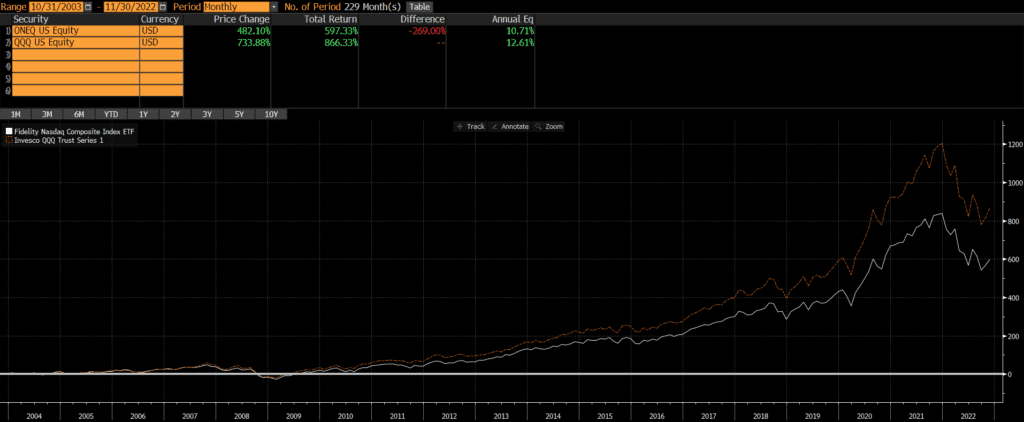QQQ is one of the largest, most popular, and most liquid ETFs. The NASDAQ Composite Index is one of the most popular and most-watched indices. Interestingly, “the Q’s” does not track the NASDAQ Composite Index; QQQ tracks the Nasdaq 100 Index. In other words, “The NASDAQ” Composite Index is referred to in the news and displayed on websites/TV, while the NASDAQ 100 Index seems to be the benchmark for more investable funds and strategies. Despite their similar names, a comparison of the ONEQ vs QQQ reveals some major differences.
The ONEQ and QQQ have very different compositions, slightly different weights and exposures, and performance differences have reflected that.
A reminder that these are simply examples as this site does NOT provide investment recommendations.
Historical Performance: ONEQ vs QQQ
QQQ is the older ETF with an inception date of March 10, 1999. ONEQ was launched just a few years later on October 1, 2003. Since that time, QQQ has outperformed ONEQ by a wide margin of nearly 2% annually. In other words, investing in “the Qs” would have beaten investing in “the Nasdaq” by quite a bit (nearly 270% over the past 19 years)!

Those looking to evaluate performance history before the 2000s should compare the index performance of these ETFs’ benchmarks and may want to read our post on the Nasdaq 100 vs Nasdaq Composite.
Investors looking for a lower cost version of QQQ may want to research QQQM and/or read my post comparing QQQM vs QQQ or ONEQ vs QQQM. Investors looking a mutual fund version of ONEQ should read my comparison of QQQ vs FNCMX.
Differences between ONEQ and QQQ
Overall, the two ETFs are very similar, since they are both based on the same universe of stocks. ONEQ holds approximately 1,000 stocks, while QQQ owns roughly 100 stocks. The NASDAQ site publishes the index methodologies for both the Composite and 100.
Geographic Exposure
Substantially all (95%+) of each ETF is composed of US-based companies, so I will not include the usual tables of countries, market classification, and so on.
Market Cap Exposure
QQQ holds the 100 largest stocks on the NASDAQ exchange (excluding financials), so it has a much larger weighting to large-caps than ONEQ which tracks the Composite Index. However, both ETFs use weighting methodologies based on market-cap, so large-caps dominate each ETF.
Below is an estimate of the market cap exposure as of 11/28/2022.
| ONEQ | QQQ | |
| Large Cap | 73% | 93% |
| Mid Cap | 16% | 7% |
| Small Cap | 10% | 0% |
Sector Weights
Given that ONEQ tracks a much broader index than QQQ, it is not surprising that the ONEQ owns more sectors and is less concentrated than QQQ. Below are the sector weightings of the two ETFs, as of 11/29/2022.
| ONEQ | QQQ | |
| Basic Materials | 0.39% | 0.00% |
| Consumer Cyclical | 14.17% | 14.25% |
| Financial Services | 5.53% | 0.85% |
| Real Estate | 1.23% | 0.00% |
| Communication Services | 13.18% | 15.25% |
| Energy | 0.82% | 0.00% |
| Industrials | 5.28% | 5.07% |
| Technology | 43.31% | 47.92% |
| Consumer Defensive | 5.08% | 7.22% |
| Healthcare | 9.89% | 7.96% |
| Utilities | 1.14% | 1.48% |
Final Thoughts: ONEQ vs QQQ
The decision of whether to invest in ONEQ vs QQQ comes down to whether an investor wants a more fund that is more concentrated in large-cap and tech or a more diversified portfolio. As the chart of ONEQ vs QQQ shows, QQQ has done better historically although this may not hold true moving forward (especially if tech and/or large-caps fall out of favor).